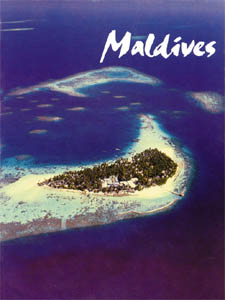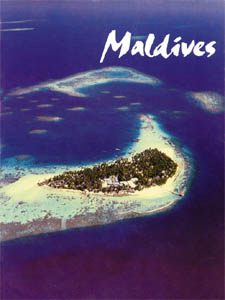
An overview of a rich history (Part 1 of 3) Maldivean royal searches for Yemeni roots [Archives:2003/03/Reportage]
January 20 2003
BY IRENA KNEHTL*
FOR THE YEMEN TIMES

Maldives in the Indian Ocean
The Maldivian archipelago lays in the most strategic position for any navigator who wanted to round the southern point of Asia. The 64 km strait between India and Sri Lanka was full of reefs and too shallow to permit safe sailing. To get around the Indian subcontinent sailing vessels had to go so far south that they also rounded Sri Lanka, and then they would inevitably have to force a passage through the long chain of the Maldive Islands.
The Maldives lay there as a treacherous barrier. No admiral could have planned a better strategic line, if he had wanted to chain off with mines a sailing route obligatory for any mariner who wanted to sail east or west past the southern point of Asia. The early navigators did not know weather they will encounter death or glory. Death will come and then the waves of the sea, they may have thought. They no longer saw land, nor sun, nor the end of the journey it seemed.
The islands are so low above the waves that, were it not for the tall coconut palms they would be invisible until the ship was cough in the surf. Only near the southern end of this long coral barricade there the channel open in two which permit safe passage through one side of India to the other. The dots on the map became alive, green jade necklaces, and scattered emerald jewelry placed on ocean blue, velvet and cloudless tropical sky. Total some 1,190 islands. In fact nobody knows for sure for some islets grow out of submerged reefs, and others are eaten away piecemeal by the ocean and disappear. Only 202 of the islands are inhabited although other have the ruins of former habitation.
Ancient maritime station
Maldives was another of the maritime way stations for some great seafaring civilizations. Also the Maldive voyages to distant lands were certainly not the result of mere hazard. Some descendants of old local builders and seafarers there still possess knowledge of ports around the ocean that surrounded their own micro world. Ports in India, Yemen, and Somalia were well known.
As early as in the 7th century Arabs, mostly Southern Arab, established an oversea trading center in Calicut. The island of Zanzibar, on the other side of the Indian Ocean, for example was part of the pre Islamic Kingdom of Saba from 115 BC to 525 BC, also known as Sheba. The Sabeans were a maritime people, with a large kingdom in Yemen and used the seasonal monsoon winds to travel regularly to and from Zanzibar. They sailed south between November to February, during the Northeast Monsoon, carrying beads, the Chinese porcelain and clothes.
Between March and September, they returned to north on the Southwest Monsoon, carrying food grains, mangroves poles for timber, spices, gold from Sofala, ivory and ebony. It is now suggested that Sabeans may have called on Maldive islands, or possessed knowledge of Maldivian archipelago.
Europeans were the late comers in this ocean. They were only very late visitors to an old maritime Maldivian sultanate. The sun and the monsoon winds had sent the early voyagers from Southern Arabia on the first expeditions into these open parts of the Indian Ocean.
The sun suggested the best place to search and the monsoon the best time to come. Seen from afar the Arab dhows may have looked like a procession, from close, it a village, with its stories, jokes, nick names, intrigues, conflicts, nights of singing and poetry, a village for which all lands are far away, even the land one comes from or the land one would be crossing. Riches consists not in the things one possesses but in the things one can do without, they chanted.
Cowrie shells islands
The wealth of the people of these islands is constituted by cowrie shells. After woods the Arabs had started to take over the ancient trade routes off the coasts of India when Sulaiman, the merchant in the period AD 850 to 900 recorded how travelers had visited the Maldives and witnessed the importance of the cowrie shells. The islanders sell them for rice to the people of Bengal, where they are used for money he writes. They are sold in the same way to the people of Yemen who use them for ship ballast in place of sand. The Arabs, in particular, southern Arabs, have taken over the trade in Maldive cowries up the Tigries river, and to the caravan routes beyond.
The geography, the location of these Maldive islands perhaps combined with the cowrie shells, had made them an important port of call or transit station for advanced civilizations navigating the Indian Ocean. The highway brought knowledge and riches, the sea provided provided protection and liberty. The ruler of these cowrie islands was customarily a queen.
The Maldivians feel strong ties and a sense of debt to the Arabs for the faith and subsequent cultural revolution – for that magic year of AD 1153 had brought them. when their kings in Male adopted Islam. The population of the islands, however, adopted Islam half a century. The Arabs brought light in a world of shadow. The introduction of Islam over eight centuries ago marked the beginning of the present era.
Ibn Battuta came to the Maldives in 1343. I resolved to go to the Dhibat AlMahal, the Arab name for Maldive islands, he writes in his Rihla. These islands are among the wonders of the world. Export from the islands are fish, coconuts, fabrics, and cotton turbans. Export are also vessels of copper, cowries, coir, Ibn Batutta writes further. This cordage is used for joining the boards of ships, and is also exported to China, Yemen and India. Slaves were brought from Hadramaut twelve generations ago to serve as a selected bodyguard for the Sultan in Male.
Merchandise from the world
Ships carrying cargo between ports in China, India, and Yemen could load and unload in the Maldives almost any merchandise from all over the world, glittering brocade, pearls and precious stones. The history further records how all lines of maritime commerce from China, Indonesia, and India drew together until the tip of South India was rounded and the Maldives were passed. Then they diverged again with different destinations.
Most ships from the east, however upon passing the Maldives would first call at the important harbor of Calicut in the south west India. From there they would either strike westward across the Indian Ocean for Yemen and the Red Sea, or call at the other flourishing ports northwards to Cambay and the Indus valley, and across to the Harmouz straits. What landed at Aden in Yemen was carried up the Red Sea for delivery to merchants in Jeddah or Cairo.
The people of Maldives with their favorable location as a midway station were able to furnish water and fresh provisions, benefited greatly from this intercontinental trade in which they themselves took part. They brought their own cowries, and smoked fish to ports as far as Bengal and Yemen. The Arab traveler Abdul Razzak records Maldive merchants among those visiting important port of Calicut and Hormus during his visit there in 1442.
Import and expthat is what the ships permitted, and how civilization began. The Maldivians settled at a crossroad of all the maritime nations knew that ocean is and always was an open road since man began to build ships.
* Irena Knehtl is an economist and writer. She has been involved in the Indian Ocean dialogue for economic cooperation and exploring economic cooperation among Red Sea countries.
This is part of a larger undertaking tracing Yemeni contacts throughout the Indian Ocean and South East Asia.
For further suggestions and comments contact The Yemen Times.
——
[archive-e:03-v:2003-y:2003-d:2003-01-20-p:./2003/iss03/report.htm]


